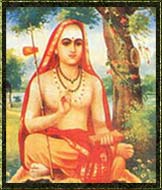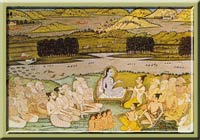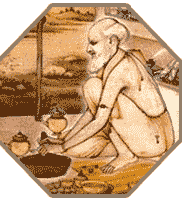INTRODUCTION

The word Veda means wisdom, knowledge or vision, and it is revered as the language of the gods in human speech. The essence of the Vedas is to regulate the social, legal, domestic and religious customs of the Hindus which is meticulously pursued to the present day. All the rituals of Hindus conducted upon birth, marriage, death etc. are based upon Vedic doctrines and they are being followed from time immemorial.
PERIOD OF THE VEDAS
The Vedas are probably the earliest documents of the human mind. As the ancient Hindus seldom kept any historical record of their religious, literary and political realization it is indeed difficult to precisely say when the earliest portions of the Vedas came into existence and what is their period. Historians provide us many guesses but none of them is free from ambiguity. However it is believed that it is in 1200 B.C., when the first Aryan immigrants in India started composing the various hymns that are part of the books.The Rig Veda is said to be date back to 1500 B.C. - 1000 B.C. Some scholars date the Rig Veda as early as 12000 B.C. - 4000 B.C. The traditional date goes back to 3000BC, something which the German scholar Max Mueller accepted. Inspite of the controversy over the period of Rig Veda going on for long time, modern historians have now reached a consensus that its oldest parts were written around a 1200 B.C. The Sama Veda, Yajur Veda and Atharva Veda were compiled after the age of the Rig Veda and are ascribed to the Vedic period.
THE FOUR VEDAS
The Rig Veda : The Book of Mantra The Rig Veda is a collection of brilliant songs or hymns and is a main source of information in detail on the social, religious, political and economic background of the Rig-Vedic civilization. It is the oldest book in any Indo-European language and contains the earliest form of all Sanskrit mantras. Even though some of the hymns of Rig Veda characterize monotheism (belief in the existence of one god), naturalistic polytheism (belief in more than one god,) and monism (belief of different paths to the one god), in general, can be found in the hymns of Rig Veda. The Rig-Vedic 'samhita' (collection of mantras) consists of 1,017 'suktas' (hymns) divided into eight 'ashtakas' (songs) each having eight 'adhyayas' (sections), which are sub-divided into various groups with a total of about 10,600 stanzas. The hymns are collection of the work of many authors called 'rishis' (according to post Vedic tradition "seers"). Atri, Kanwa,Vashistha, Vishwamitra, Jamadagni, Gotama and Bharadwaja are considered as the seven primary seers.The hymns are devoted to thirty-three different gods, most of them nature gods like Indra (rain god), Agni (fire god), Rudra (storm god) etc. A sizeable chunk of the verses are also dedicated to Soma (air god).
The Sama Veda : The Book of Chant

Sama Veda was meant for the priests who performed the rituals of the soma ceremonies [rituals of the threefold realm of life & death (samsara)]. As time went on rituals and ceremonies of worship became increasingly complex and so a need arose to compile all the rituals and their chants in a book, as a sort of reference point for the priests. The emphasis was on the specific style of its poetry and its literary content had no relevance. There are also very strict instructions in SamaVeda as to how particular hymns must be sung. Great emphasis was put upon sounds of the words of the mantras so that they could have accomplished effects on the environment and the person who pronounced them.
The Yajur Veda : The Book of Ritual The Yajur-Veda or the wisdom of sacrifices is also a liturgical collection and was made to meet the demands of a ceremonial religion. It lays down various "yajurs" (sacred incantations) which were chanted by a particular sect of priests called adhvaryu. They performed the sacrificial rites. The Yajur Veda practically served as a guidebook for the priests who execute sacrificial acts and at the same time uttering the prayers and the sacrificial yajurs. Few hymns are also attributed to various Gods. However, the core of the Veda is dedicated to the theory of the rituals thereby making it very much ritual based. Many chants for the purpose of praying and paying respect to the various instruments that are involved in the sacrifices could also be seen the Veda. Not less than six complete recessions of Yajur Veda, viz. Madyandina, Kanva, Taittiriya, Kathaka, Maitrayani and Kapishthala are available now.
The Atharva Veda : The Book of Spell

AUTHORS OF VEDAS
There is a strong belief among the Hindus that the revered compositions of the Vedas passed on through generations by the word of mouth from time immemorial and hence the general assumption is that the Vedic hymns were either taught by God to the sages or that they were revealed themselves to "mantradrasta" (seers). It is Vyasa Krishna Dwaipayana who was the key player in compiling the Vedas around the time of Lord Krishna (c. 1500 BC)DIFFERENT DIVISIONS OF VEDAS
Each Veda consists of four parts:The Samhitas (hymns): A collection of mantras or hymns.
The Brahmanas (rituals): The Brahmanas are ritualistic texts and include guidelines and religious duties. Each Veda has several Brahmanas attached to it.
The Aranyakas (theologies): The Aryanyakas, meaning forest texts intend to serve as a guide of meditation for ascetics who live in forests and lead a lifestyle characterized by abstinence from various sorts of worldly pleasures often with the aim of pursuing religious and spiritual goals.
The Upanishads (philosophies): The Upanishads form the concluding portions of the Veda and therefore called the "Vedanta" or the end of the Veda and contains the essence of Vedic teachings. The Upanishads along with the Aranyakas are the concluding portions of the Brahmanas, which discuss philosophical problems.
CONCLUSION
The Upanishads are a set of guidelines that pave way to attain brahma-knowledge through Vedanta. The different derivations together make out that they give us both spiritual vision and philosophical reasoning.The sages who discovered them wanted to go beyond nature in search of transcendental nature of man. They dared to take up this challenge and the Upanishads are the unique record of the methods they adopted, the struggles they undertook and the victory they achieved in this astonishing adventure of human spirit. In seeking the immortal, the sages conferred the immortality upon the literature they have passed on to us.One of the oldest and longest of the Upanishads, the Brihadaranyaka says: "From the unreal lead me to the real! From darkness lead me to light! From death lead me to immortality!"The crux of the Upanishads is that this can be achieved by meditating with the awareness that one's soul ('atman') is one with all things, and that 'one' is 'Brahman', which becomes the 'all'..


